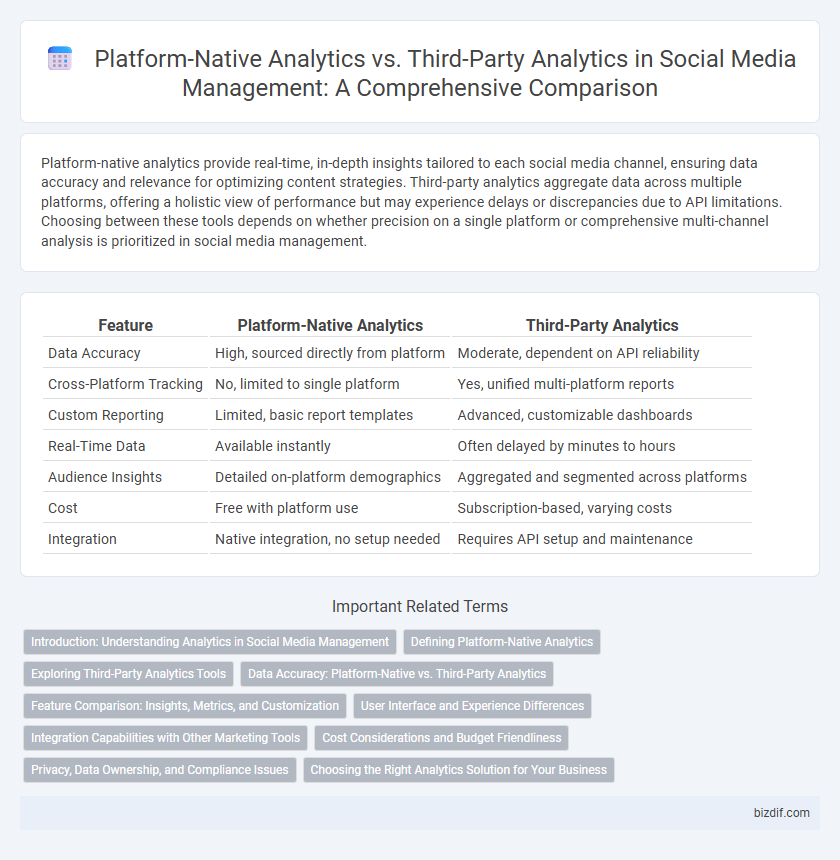Platform-native analytics provide real-time, in-depth insights tailored to each social media channel, ensuring data accuracy and relevance for optimizing content strategies. Third-party analytics aggregate data across multiple platforms, offering a holistic view of performance but may experience delays or discrepancies due to API limitations. Choosing between these tools depends on whether precision on a single platform or comprehensive multi-channel analysis is prioritized in social media management.
Table of Comparison
| Feature | Platform-Native Analytics | Third-Party Analytics |
|---|---|---|
| Data Accuracy | High, sourced directly from platform | Moderate, dependent on API reliability |
| Cross-Platform Tracking | No, limited to single platform | Yes, unified multi-platform reports |
| Custom Reporting | Limited, basic report templates | Advanced, customizable dashboards |
| Real-Time Data | Available instantly | Often delayed by minutes to hours |
| Audience Insights | Detailed on-platform demographics | Aggregated and segmented across platforms |
| Cost | Free with platform use | Subscription-based, varying costs |
| Integration | Native integration, no setup needed | Requires API setup and maintenance |
Introduction: Understanding Analytics in Social Media Management
Platform-native analytics provide real-time, in-depth insights directly from social media channels like Facebook Insights or Twitter Analytics, ensuring data accuracy and immediate relevance. Third-party analytics tools aggregate data across multiple platforms, offering comprehensive cross-channel performance metrics and advanced reporting capabilities. Understanding the strengths and limitations of both types is essential for effective social media management and data-driven decision-making.
Defining Platform-Native Analytics
Platform-native analytics provide real-time insights directly within social media platforms like Facebook, Instagram, and Twitter, offering data on engagement, reach, and audience demographics. These built-in tools leverage platform-specific algorithms to deliver highly accurate and context-rich metrics tailored to each network's unique environment. By using platform-native analytics, social media managers gain immediate access to detailed performance indicators essential for optimizing content strategy and campaign effectiveness.
Exploring Third-Party Analytics Tools
Third-party analytics tools provide comprehensive insights by aggregating data across multiple social media platforms, enabling more detailed performance tracking compared to platform-native analytics. These tools offer advanced features such as competitor benchmarking, sentiment analysis, and customizable reporting that enhance strategic decision-making. Brands leveraging third-party analytics gain a holistic view of audience behavior, campaign effectiveness, and market trends beyond native limitations.
Data Accuracy: Platform-Native vs. Third-Party Analytics
Platform-native analytics provide highly accurate and real-time data directly from the social media platform's algorithms and user behavior tracking, ensuring reliability and consistency. Third-party analytics often aggregate data across multiple platforms but may experience discrepancies due to API limitations, data delays, or sampling errors. For precise measurement of engagement metrics, reach, and conversions, platform-native analytics remain the preferred choice for social media managers seeking data accuracy.
Feature Comparison: Insights, Metrics, and Customization
Platform-native analytics provide real-time insights directly from social media networks, offering detailed metrics such as engagement rates, audience demographics, and content performance tailored specifically to each platform. Third-party analytics tools aggregate data across multiple social media channels, enabling comprehensive cross-platform analysis with customizable dashboards and advanced features like sentiment analysis and competitive benchmarking. While platform-native analytics excel in accuracy and immediacy, third-party solutions offer greater flexibility in reporting and deeper multi-channel insights for holistic social media management.
User Interface and Experience Differences
Platform-native analytics offer user interfaces designed specifically for each social media site, providing seamless navigation and real-time data updates tailored to that platform's features. Third-party analytics tools consolidate insights from multiple social networks into a unified dashboard, often prioritizing customizable reports and broader data comparisons at the expense of some platform-specific nuances. The user experience differs as native analytics emphasize intuitive, in-depth interaction within one environment while third-party solutions focus on cross-platform efficiency and aggregated metrics.
Integration Capabilities with Other Marketing Tools
Platform-native analytics offer seamless integration with their respective social media ecosystems, ensuring real-time data synchronization and consistent user experiences. Third-party analytics tools provide broader compatibility across multiple platforms, enabling marketers to consolidate data streams from diverse sources into unified dashboards. Effective integration with CRM systems, email marketing software, and advertising platforms enhances the holistic view of campaign performance and facilitates informed decision-making.
Cost Considerations and Budget Friendliness
Platform-native analytics often provide cost-effective solutions with no additional fees since they are included within the social media platform's service. Third-party analytics tools typically require subscription fees, which can vary based on features and data access levels, impacting overall budget planning. Businesses must weigh budget constraints against the need for advanced insights and customizable reporting when choosing between native and third-party options.
Privacy, Data Ownership, and Compliance Issues
Platform-native analytics offer direct access to user data while ensuring compliance with specific social media channels' privacy policies and data ownership rules. Third-party analytics tools aggregate data from multiple platforms but may pose higher risks regarding data privacy, ownership disputes, and compliance with regulations like GDPR or CCPA. Businesses must evaluate these trade-offs to maintain data security and adhere to legal requirements in social media management.
Choosing the Right Analytics Solution for Your Business
Platform-native analytics provide real-time, in-depth insights directly from social media channels like Facebook Insights or Twitter Analytics, ensuring data accuracy and seamless integration. Third-party analytics tools, such as Hootsuite or Sprout Social, offer comprehensive cross-platform reporting, advanced audience segmentation, and customizable metrics ideal for businesses managing multiple social accounts. Selecting the right analytics solution depends on your business needs, prioritizing factors like budget, scope of data, and the value of unified reporting versus platform-specific precision.
Platform-native analytics vs Third-party analytics Infographic

 bizdif.com
bizdif.com